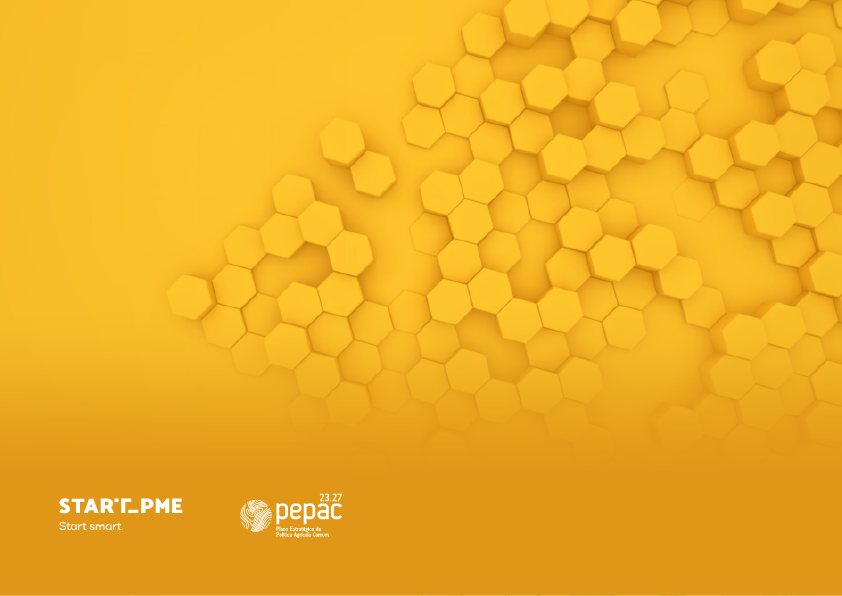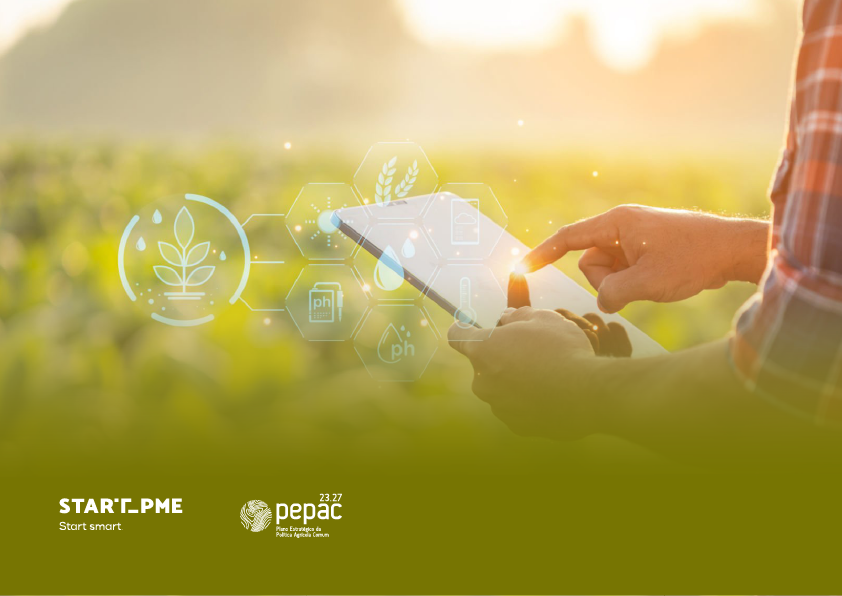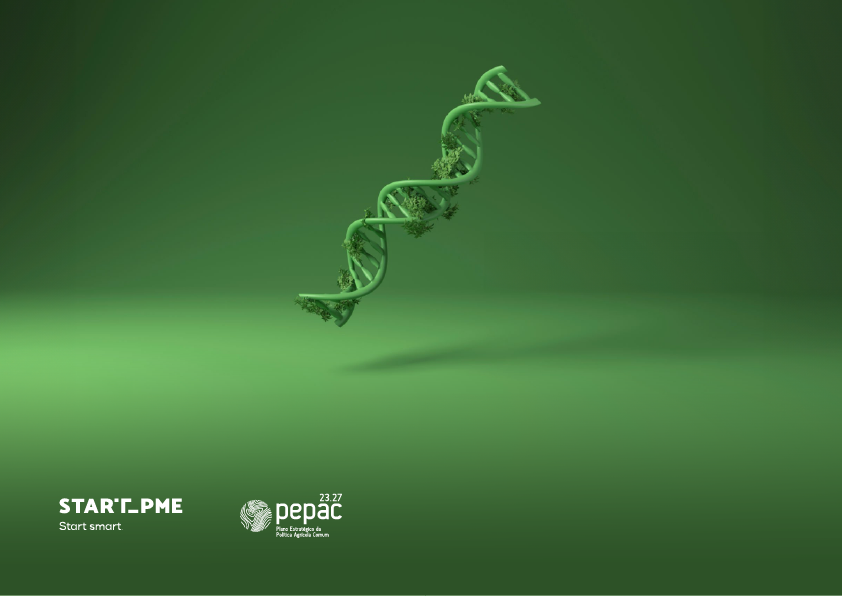Project Description

Non-Productive Investments
PEPAC
This incentive contributes to strengthening the achievement of the specific agri-environment-climate objectives considered relevant, namely those related to the sustainable management of natural resources, protection of biodiversity and preservation of habitats and landscapes through operations with a contribution to the protection of biodiversity.
Support Status
Preliminary Stage
Financing
Up to 70.000€
Territory
National Territory
Eligible Entities
Farmers

Non-Productive Investments
PEPAC
This incentive contributes to strengthening the achievement of the specific agri-environment-climate objectives considered relevant, namely those related to the sustainable management of natural resources, protection of biodiversity and preservation of habitats and landscapes through operations with a contribution to the protection of biodiversity.
Support Status
Preliminary Stage
Financing
Up to 70.000€
Territory
National Territory
Eligible Entities
Farmers
Incentive Conditions
- This intervention contributes to the following PEPAC targets:
- Percentage of farms benefiting from CAP support for productive and non-productive investments related to the protection of natural resources;
- Percentage of farms benefiting from CAP investment support that contributes to biodiversity.
- Protection of biodiversity and eradication of woody invasive species, installation/restoration of ecological focus structures, protection of water and soil resources, installation of nests or shelters for birds of prey, scavengers or bats and installation of protection systems against wild predators (with and without protection status).
- National Territory.
- Individuals or legal entities engaged in agricultural activity.
- The investment project/intervention plan must locate the areas to be benefited on the farm, demonstrating technical coherence and alignment with the specific environmental and climate objectives of PEPAC;
- Comply with the legal provisions applicable to the proposed investments, particularly in terms of licensing;
- The investment project/Intervention Plan has received a positive opinion from the relevant authority in the following areas of intervention:
- 1. Protecting and restoring biodiversity, habitats and the traditional landscape:
- Recovery of stone retaining walls;
- Installation or restoration of riparian galleries on agricultural or agroforestry land;
- Installation or restoration of living hedges, rows of trees, groves, walls;
- Installation of shelters, nests and systems to protect the nests of birds with vulnerable, endangered or critically endangered status from predators;
- Installation of buffer strips with palustrine and/or riparian vegetation on the banks of watercourses and on the slopes of drainage ditches;
- Eradication of woody invasive species;
- Eradication of aquatic invasive species;
- Installation of protection systems against attacks by Iberian wolves, wild boars and other wild predators;
- Non-productive investments associated with the interventions: “Agri-environmental Zonal Plans”; “Management of the montando by results” and “Integrated management in critical areas”.
- 2. Protection of natural resources:
- Restoration of stone retaining walls (excluding those under typology 1);
- Installation of protective strips with palustrine and/or riparian vegetation on the banks of water lines and on the slopes of drainage ditches;
- Installation or restoration of natural rainwater drainage lines on sloping soils, ravines and cliffs;
- Installing strips of shrub or bush vegetation along contour lines to prevent erosion on agroforestry areas with a PQSI (plot physiographic qualification index) ≥4;
- Other non-productive investment operations that contribute to the area of protection of natural resources which, during the monitoring and evaluation of the Plans, prove to be fundamental to achieving the objectives of the intervention, defined in a notice by the PEPAC Managing Authority.
- 1. Protecting and restoring biodiversity, habitats and the traditional landscape:
- All tangible expenses deemed necessary to carry out the different types of non-productive investment are eligible for funding, namely:
- Recovery of stone support walls – Purchase of materials and services The purchase of materials and services, taking into account their normal market values, and contributions in kind, provided they refer to the supply of equipment or unpaid voluntary work, up to the limit of self-financing, relating to the costs of restoring stone walls;
- Installation or restoration of riparian galleries on agricultural and/or agroforestry land – Acquisition of materials and services, given their normal market values, and contributions in kind, provided they refer to the supply of equipment or unpaid voluntary work, up to the self-financing limit, relating to:
- Regulating and stabilizing the banks of watercourses, where sealing is prohibited waterproofing;
- Planting with suitable species or taking advantage of natural regeneration;
- Purchasing and installing individual plant protection;
- Destroying and controlling invasive species;
- Removal of unsuitable vegetation;
- Removing excess branches and pruning riparian vegetation;
- Destroying stumps (of dead trees).
- Installation or restoration of living hedges, rows of trees, groves, walls – Purchase of materials and services, given their normal market values, and contributions in kind, provided they relate to the supply of equipment or unpaid voluntary work, up to the self-financing limit, relating to:
- Soil preparation for the installation of structures of ecological interest;
- Plant with suitable species or take advantage of those already existing in the area to be intervened;
- The walls should be built in accordance with the traditional method used in the area using granite or schist, without the use of mortar (dry stone walls);
- Purchase and install individual plant protectors;
- Destruction and control of invasive species;
- Removal of unsuitable vegetation;
- Removal of excess branches and pruning of vegetation to be maintained;
- Destroying stumps (of dead trees).
- Installation of shelters, nests and nest protection systems for birds with vulnerable, endangered or critical status.
- Installation of protection strips with palustrine and/or riparian vegetation on the banks of water lines and on the slopes of drainage ditches – Acquisition of materials and services, given their normal market values, and contributions in kind, provided that they refer to the supply of equipment or unpaid voluntary work, up to the self-financing limit.
- Regulating and stabilizing the banks of watercourses, with sealing prohibited;
- Planting with suitable species or taking advantage of natural regeneration;
- Purchasing and installing individual plant protection;
- Destroying and controlling invasive species;
- Removal of unsuitable vegetation.
- Eradication of woody invasive species – Purchase of materials and services, taking into account the respective normal market values, and contributions in kind, provided that they refer to the supply of equipment or unpaid voluntary work up to the self-financing limit, relating to:
- Preventive and management interventions such as pruning and trimming, removal of unsuitable vegetation, controlled fire and destruction of stumps;
- Plant protection treatments, when recommended by the ICNF or delegated;
- Destruction and control of invasive species.
- Eradication of aquatic invasive species – Acquisition of materials and services, taking into account their normal market values, and contributions in kind, as long as they refer to the supply of equipment or unpaid voluntary work, up to the self-financing limit.
- Preventive and management interventions such as the control of excessive aquatic vegetation and the removal of unsuitable vegetation on banks and slopes;
- Destruction and control of invasive species.
- Installation of protection systems against attacks by Iberian wolves, wild boars and other wild predators – Purchase of materials and services, given their normal market values, and normal market values, and contributions in kind, as long as they refer to the provision of equipment or unpaid voluntary work, up to the self-financing limit, relating to the acquisition and installation of the protection systems to be supported.
- Installation of drinking fountains, water tanks and other water points for wildlife – Purchase of materials and services, given their normal market values, relating to the acquisition and installation of the wildlife support systems to be financed.
- Installation or restoration of natural rainwater drainage lines in Purchase of materials and services, given their normal market values and contributions in kind, provided they relate to the supply of equipment or unpaid voluntary work up to the self-financing limit, relating to the regularization of natural drainage lines in need of intervention.
- Installation of strips of shrub or bush vegetation along contour lines to prevent erosion on agroforestry areas with an IQFP ≥4 – Purchase of materials and services, given their normal market values, and contributions in kind, provided they relate to the supply of equipment or unpaid voluntary work, up to the self-financing limit, relating to:
- Preparing the soil for the installation of strips of shrub or bush vegetation;
- Planting with suitable species, preferably native and adapted to the region;
- Purchasing and installing individual plant protectors;
- Destroying and controlling invasive species;
- Removal of unsuitable vegetation.
- The types and categories of expenditure listed in Article 73(3) of the PEPAC Regulation are not eligible.
- Non-reimbursable support for simplified costs:
| Support (€/m3 of restored wall) | Condition |
|---|---|
| 130 € | Wall located in the geographical area corresponding to the so-called “Peneda -Gerês zonal support”; |
| 200 € | Wall located in the geographical area corresponding to the Douro Demarcated Region. |
- Support is limited during the programming period to a maximum eligible amount of €30,000, except in the Douro Demarcated Region, where the limit is €70,000.
- Other types – Non-reimbursable support against a 100% invoice.
Incentive Conditions
This intervention contributes to the following PEPAC targets:
Percentage of farms benefiting from CAP support for productive and non-productive investments related to the protection of natural resources;
Percentage of farms benefiting from CAP investment support that contributes to biodiversity.
Protection of biodiversity and eradication of woody invasive species, installation/restoration of ecological focus structures, protection of water and soil resources, installation of nests or shelters for birds of prey, scavengers or bats and installation of protection systems against wild predators (with and without protection status).
National Territory.
Individuals or legal entities engaged in agricultural activity.
The investment project/intervention plan must locate the areas to be benefited on the farm, demonstrating technical coherence and alignment with the specific environmental and climate objectives of PEPAC;
Comply with the legal provisions applicable to the proposed investments, particularly in terms of licensing;
The investment project/Intervention Plan has received a positive opinion from the relevant authority in the following areas of intervention:
1. Protecting and restoring biodiversity, habitats and the traditional landscape:
Recovery of stone retaining walls;
Installation or restoration of riparian galleries on agricultural or agroforestry land;
Installation or restoration of living hedges, rows of trees, groves, walls;
Installation of shelters, nests and systems to protect the nests of birds with vulnerable, endangered or critically endangered status from predators;
Installation of buffer strips with palustrine and/or riparian vegetation on the banks of watercourses and on the slopes of drainage ditches;
Eradication of woody invasive species;
Eradication of aquatic invasive species;
Installation of protection systems against attacks by Iberian wolves, wild boars and other wild predators;
Non-productive investments associated with the interventions: “Agri-environmental Zonal Plans”; “Management of the montando by results” and “Integrated management in critical areas”.
2. Protection of natural resources:
Restoration of stone retaining walls (excluding those under typology 1);
Installation of protective strips with palustrine and/or riparian vegetation on the banks of water lines and on the slopes of drainage ditches;
Installation or restoration of natural rainwater drainage lines on sloping soils, ravines and cliffs;
Installing strips of shrub or bush vegetation along contour lines to prevent erosion on agroforestry areas with a PQSI (plot physiographic qualification index) ≥4;
Other non-productive investment operations that contribute to the area of protection of natural resources which, during the monitoring and evaluation of the Plans, prove to be fundamental to achieving the objectives of the intervention, defined in a notice by the PEPAC Managing Authority.
All tangible expenses deemed necessary to carry out the different types of non-productive investment are eligible for funding, namely:
Recovery of stone support walls – Purchase of materials and services The purchase of materials and services, taking into account their normal market values, and contributions in kind, provided they refer to the supply of equipment or unpaid voluntary work, up to the limit of self-financing, relating to the costs of restoring stone walls;
Installation or restoration of riparian galleries on agricultural and/or agroforestry land – Acquisition of materials and services, given their normal market values, and contributions in kind, provided they refer to the supply of equipment or unpaid voluntary work, up to the self-financing limit, relating to:
Regulating and stabilizing the banks of watercourses, where sealing is prohibited waterproofing;
Planting with suitable species or taking advantage of natural regeneration;
Purchasing and installing individual plant protection;
Destroying and controlling invasive species;
Removal of unsuitable vegetation;
Removing excess branches and pruning riparian vegetation;
Destroying stumps (of dead trees).
Installation or restoration of living hedges, rows of trees, groves, walls – Purchase of materials and services, given their normal market values, and contributions in kind, provided they relate to the supply of equipment or unpaid voluntary work, up to the self-financing limit, relating to:
Soil preparation for the installation of structures of ecological interest;
Plant with suitable species or take advantage of those already existing in the area to be intervened;
The walls should be built in accordance with the traditional method used in the area using granite or schist, without the use of mortar (dry stone walls);
Purchase and install individual plant protectors;
Destruction and control of invasive species;
Removal of unsuitable vegetation;
Removal of excess branches and pruning of vegetation to be maintained;
Destroying stumps (of dead trees).
Installation of shelters, nests and nest protection systems for birds with vulnerable, endangered or critical status.
Installation of protection strips with palustrine and/or riparian vegetation on the banks of water lines and on the slopes of drainage ditches – Acquisition of materials and services, given their normal market values, and contributions in kind, provided that they refer to the supply of equipment or unpaid voluntary work, up to the self-financing limit.
Regulating and stabilizing the banks of watercourses, with sealing prohibited;
Planting with suitable species or taking advantage of natural regeneration;
Purchasing and installing individual plant protection;
Destroying and controlling invasive species;
Removal of unsuitable vegetation.
Eradication of woody invasive species – Purchase of materials and services, taking into account the respective normal market values, and contributions in kind, provided that they refer to the supply of equipment or unpaid voluntary work up to the self-financing limit, relating to:
Preventive and management interventions such as pruning and trimming, removal of unsuitable vegetation, controlled fire and destruction of stumps;
Plant protection treatments, when recommended by the ICNF or delegated;
Destruction and control of invasive species.
Eradication of aquatic invasive species – Acquisition of materials and services, taking into account their normal market values, and contributions in kind, as long as they refer to the supply of equipment or unpaid voluntary work, up to the self-financing limit.
Preventive and management interventions such as the control of excessive aquatic vegetation and the removal of unsuitable vegetation on banks and slopes;
Destruction and control of invasive species.
Installation of protection systems against attacks by Iberian wolves, wild boars and other wild predators – Purchase of materials and services, given their normal market values, and normal market values, and contributions in kind, as long as they refer to the provision of equipment or unpaid voluntary work, up to the self-financing limit, relating to the acquisition and installation of the protection systems to be supported.
Installation of drinking fountains, water tanks and other water points for wildlife – Purchase of materials and services, given their normal market values, relating to the acquisition and installation of the wildlife support systems to be financed.
Installation or restoration of natural rainwater drainage lines in Purchase of materials and services, given their normal market values and contributions in kind, provided they relate to the supply of equipment or unpaid voluntary work up to the self-financing limit, relating to the regularization of natural drainage lines in need of intervention.
Installation of strips of shrub or bush vegetation along contour lines to prevent erosion on agroforestry areas with an IQFP ≥4 – Purchase of materials and services, given their normal market values, and contributions in kind, provided they relate to the supply of equipment or unpaid voluntary work, up to the self-financing limit, relating to:
Preparing the soil for the installation of strips of shrub or bush vegetation;
Planting with suitable species, preferably native and adapted to the region;
Purchasing and installing individual plant protectors;
Destroying and controlling invasive species;
Removal of unsuitable vegetation.
The types and categories of expenditure listed in Article 73(3) of the PEPAC Regulation are not eligible.
Non-reimbursable support for simplified costs:
| Support (€/m3 of restored wall) | Condition |
|---|---|
| 130 € | Wall located in the geographical area corresponding to the so-called “Peneda -Gerês zonal support”; |
| 200 € | Wall located in the geographical area corresponding to the Douro Demarcated Region. |
Support is limited during the programming period to a maximum eligible amount of €30,000, except in the Douro Demarcated Region, where the limit is €70,000.
Other types – Non-reimbursable support against a 100% invoice.





